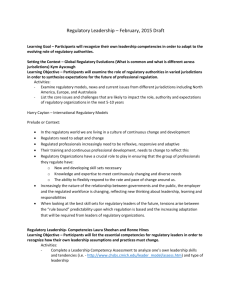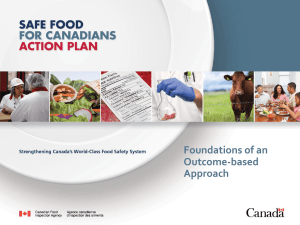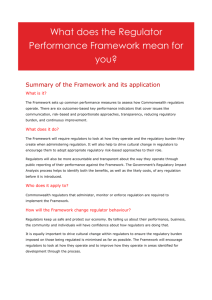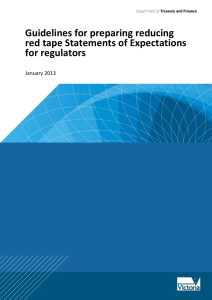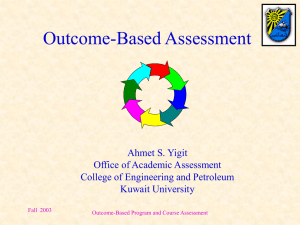Video transcript
advertisement
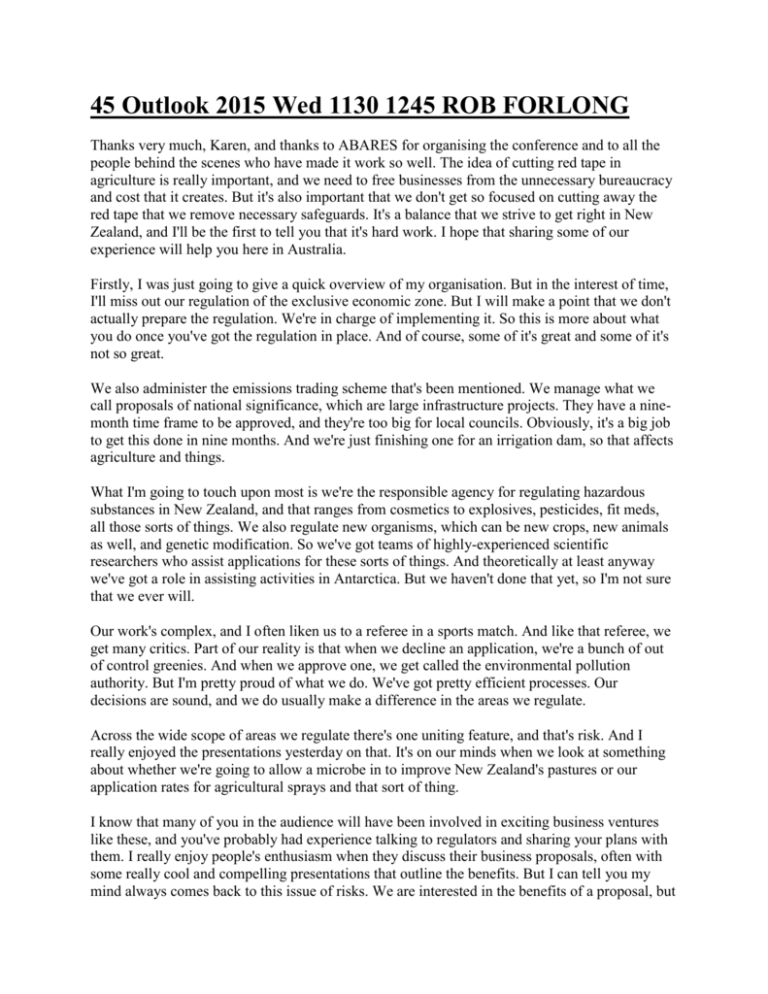
45 Outlook 2015 Wed 1130 1245 ROB FORLONG Thanks very much, Karen, and thanks to ABARES for organising the conference and to all the people behind the scenes who have made it work so well. The idea of cutting red tape in agriculture is really important, and we need to free businesses from the unnecessary bureaucracy and cost that it creates. But it's also important that we don't get so focused on cutting away the red tape that we remove necessary safeguards. It's a balance that we strive to get right in New Zealand, and I'll be the first to tell you that it's hard work. I hope that sharing some of our experience will help you here in Australia. Firstly, I was just going to give a quick overview of my organisation. But in the interest of time, I'll miss out our regulation of the exclusive economic zone. But I will make a point that we don't actually prepare the regulation. We're in charge of implementing it. So this is more about what you do once you've got the regulation in place. And of course, some of it's great and some of it's not so great. We also administer the emissions trading scheme that's been mentioned. We manage what we call proposals of national significance, which are large infrastructure projects. They have a ninemonth time frame to be approved, and they're too big for local councils. Obviously, it's a big job to get this done in nine months. And we're just finishing one for an irrigation dam, so that affects agriculture and things. What I'm going to touch upon most is we're the responsible agency for regulating hazardous substances in New Zealand, and that ranges from cosmetics to explosives, pesticides, fit meds, all those sorts of things. We also regulate new organisms, which can be new crops, new animals as well, and genetic modification. So we've got teams of highly-experienced scientific researchers who assist applications for these sorts of things. And theoretically at least anyway we've got a role in assisting activities in Antarctica. But we haven't done that yet, so I'm not sure that we ever will. Our work's complex, and I often liken us to a referee in a sports match. And like that referee, we get many critics. Part of our reality is that when we decline an application, we're a bunch of out of control greenies. And when we approve one, we get called the environmental pollution authority. But I'm pretty proud of what we do. We've got pretty efficient processes. Our decisions are sound, and we do usually make a difference in the areas we regulate. Across the wide scope of areas we regulate there's one uniting feature, and that's risk. And I really enjoyed the presentations yesterday on that. It's on our minds when we look at something about whether we're going to allow a microbe in to improve New Zealand's pastures or our application rates for agricultural sprays and that sort of thing. I know that many of you in the audience will have been involved in exciting business ventures like these, and you've probably had experience talking to regulators and sharing your plans with them. I really enjoy people's enthusiasm when they discuss their business proposals, often with some really cool and compelling presentations that outline the benefits. But I can tell you my mind always comes back to this issue of risks. We are interested in the benefits of a proposal, but we're also really interested in how the risk will be managed. It's how our sad little regulatory brains work. The other point I want to make about our sad little regulatory brains is we always look beyond the PowerPoint. What a company actually does on the ground to reduce risk is far more important to me than the fancy documentation or what they talk about doing. And I know that's the same as for all dedicated regulators. We're all looking past the shiny, polished side of the ball to see what's on the other side. Of course, as regulators we see more than our share of bad practise. And I'd love to have a bunch of companies like Terry's just to regulate, but that's not what they all are. And as a result, it's tempting for us to be overly conservative and try and eliminate all risk, even though we know that it's not practical or even possible. I think as a regulator and as a society we have to realise the limits of regulation and be very clear about that. Nothing, including regulation, can ever eliminate all risk. And if we completely tie people up in red tape, there's still going to be those who break out and go beyond the rules. So as a society, the role of regulation has to be acknowledged and confined to reducing risk and never eliminating it entirely. Because no matter how much regulation is in place, something can always go wrong. The reality is that when things do go wrong, the regulator gets to share the blame with the perpetrator. It gets called regulatory failure, even when the rules have clearly been broken. In New Zealand, regulators have shared the blame for things as diverse as leaky buildings and finance company collapses. It's interesting, because no one ever expects the police to catch every criminal before they commit a crime. But we often expect the regulatory system to prevent things from going wrong within our environmental and safety systems, and I'm thinking of frozen berries here. Regulation does two things. Firstly, it reduces, but never eliminates, the chance of something going wrong. And secondly, it ensures there are consequences for rule breakers. I always worry when the latest piece of regulation goes up before parliament and someone claims it'll fix a problem. It never will fix it by itself. So what can our experience offer Australia as you act to cut some of the red tape involved in regulating agriculture? I'd really like to be able to offer you exactly this, a silver bullet. Surely there should be some standard, fail-safe way of regulating that makes the public feel engaged, allows businesses to turn profits, and vanquishes all possible risks. But of course, there is none. The tools we use are far less whiz bang. Looking at the shoes here, as regulators we need to get out and see what's happening on the ground so that we can see the reality of the regulated parties and particularly how our regulation affects their costs and practises. We also need to sit down with people and listen to them, and we also need to explain what they need to do and why. Answer their questions so that they know what's important. Looking at the pen here, we need to truly take note of what people are saying. Given that a regulator exerts some considerable power over a regulated party, it can take some bravery for them to tell us we've got it wrong. However, I've found that sometimes when people tell us we've got it wrong, they're exactly right. And looking at the phone here, we need to keep in contact and maintain that relationship, all being available to accept feedback. We need to maintain that relationship not only with regulated parties but with interest groups in the community while maintaining our own levels of impartiality. So while regulators have laws to back us up, we ultimately regulate with the permission of the community and the regulated parties. And we need to act in a way that allows those people and businesses to build trust in us. At the EPA, we try and do this by being predictable, providing strong customer service, and by following through with what we say we're going to do. It doesn't always make people like us, but it does help to build some mutual trust and respect. In addition, we need to keep up with the developments all around the world so that we can make sure that what we're doing is best practise. It's through employing these sorts of tools that I've learnt that cutting red tape is a really complex proposition. And there are many reasons for that, some of which you've already heard today. I'd just like to address some of the issues that we faced when we moved to outcome-based regulation, which is a fashionable way-- and you've heard Terry talk about it-- of reducing the regulatory burden. But like everything, it's not perfect. Essentially, it seeks to make rules less prescriptive, and instead regulated parties have a choice to how they achieve the end result. The speed limit is a classic regulatory tool used to reduce the road toll. We all know it's designed to save lives, but it still frustrates us. Sometimes at 2 o'clock in the morning on a dead straight road, there's no reason not to go faster. And then in bad conditions, the speed limit's equally unsuitable. It's a classic example of prescriptive regulation and takes no account of driver skill, the safety of the car, and often the state of the road. If the goal is simply to have drivers keep to a safe speed for the conditions, why not move to an outcome-based regulation and replace it with a rule like this? We'd probably all consider ourselves to be good judges of a safe speed. In fact, I've read that over 80% of drivers reckon that they're better than average. Certainly, we have no incentive to hurt other road users. But what happens when you're in a hurry? When've you budgeted enough time to get there in the dry, but it starts to hose down? Safe becomes a shaky ideal. So here, we see one problem. Our motivation to use good judgement, and in fact our good judgement itself, is not always reliable. I don't want to bring up a sore point about pavlova, so I'm not going to talk about that. But what I do want to do is illustrate another difficulty in looking at outcome-based regulation. For an experienced baker, a pavlova is pretty straightforward. The ingredients are simple. And if you follow the steps carefully and avoid humid weather, you should end up with something that looks vaguely like this. But for a kitchen novice like me, it's an absolute nightmare. The chances of ending up with a perfect pav are virtually nil, and I'd end up smearing cream on something that resembled a cow pat. It's similar when we look at our outcome-based system of regulating hazardous substances like pesticides. Larger businesses and innovative businesses either have their own internal expertise or they can afford to buy it, so they usually have few problems meeting the limits and targets. They actually don't need to be told what to do. It's the small and inexperienced outfits that tend to run into trouble. Often they don't have the expertise, time, and money to devise their own strategies, for example, to use chemicals safely. New Zealand's farmers, like Australia's probably, are renowned as doers. Most of them would much rather be applying fertiliser than preparing a detailed chemical management strategy. So expecting them to do so is a bit like showing your average person a picture of a pav and then saying, off you go. Go to it. The least we can do is give them a recipe and show them a tip or two about beating eggs. So the point I want to make here is sometimes the small businesses, they're actually more burdened by outcome-based regulation if you cut that red tape too far. It sets them up to fail. If you're going to go with outcome-based regulation, you also need some simple, clear guidelines to make it easy for those businesses to remain compliant. I'll move on from pavlova now, because obviously hazardous substances are a little more complex than making dessert. For one, we're dealing with thousands of chemicals with different properties and levels of risks. New formulations come in every week. And that myriad of products are being used by hundreds of thousands of people in different workplaces, and all of those people have different levels of skills and expertise. And yet, on the other hand, we need to keep our rules simple enough to be workable. So obviously, a "one size fits all" isn't going to work. Neither is one rule for every situation. So it's important that we get our balance points right. In New Zealand, we've found some good opportunities to reduce red tape in the hazardous substances sector. And just by way of an example, we had a situation where two organisations were both working on issuing separate approvals for new veterinary medicines. We were doing it from an environmental perspective, and a section of our Ministry of Primary Industries was doing it from a food safety line. That meant obviously that importers and manufacturers had to go through the same red type twice. We started to reduce this by the two agencies sharing their data to reduce compliance costs. But in the end, basically we got sick of it. And we decided that the best option was for the EPA to remove ourselves from active regulation in this area, knowing that the Ministry of Primary Industries was actually covering off what they needed to and that those parties being regulated would appreciate both the cost savings and having one less layer of red tape. We also have other systems, two tools that we call group standards and what we call rapid similar approvals for regulating similar products. This means that importers and manufacturers with a product similar to something already on the market can avoid some of the red tape by going through an abbreviated process. Where approvals are required, the cost is relatively inexpensive and the time frames sit in statute. That means that regulated parties know when they can expect their approval and can plan accordingly. The issue for us is we always get a hugely busy period for ag comms in winter, ready for the spring launch. So it all comes down to striking the right balance, and that's what I've tried to explain to you here this morning. To summarise, we need to keep totally focused on risk. It's central to everything we do. We need to have open two-way communication between the regulator and those being regulated. And as a regulator, we've got to provide strong customer service, manage our costs, and be clear about our intentions and follow through. And finally-- this is probably the hardest task of all-- we need to keep the system as simple as we can and as flexible as we can. So thanks for asking us to share our experiences with you. I just want to acknowledge here the benefit that we in New Zealand get from the Australian regulators. I see APVMA have a stall out there, and NICNAS in this area and some of our other areas, NOPSEMA and other regulators, because we've got a great tradition of working together. So I look forward to your questions. Thanks very much.

